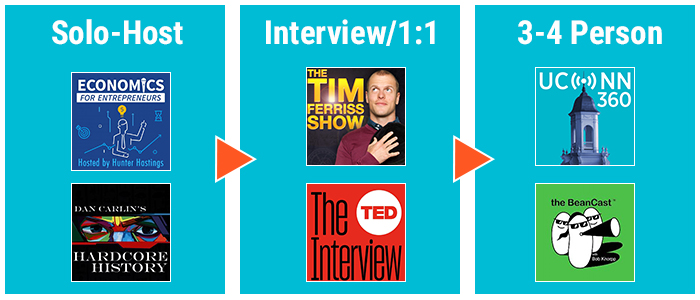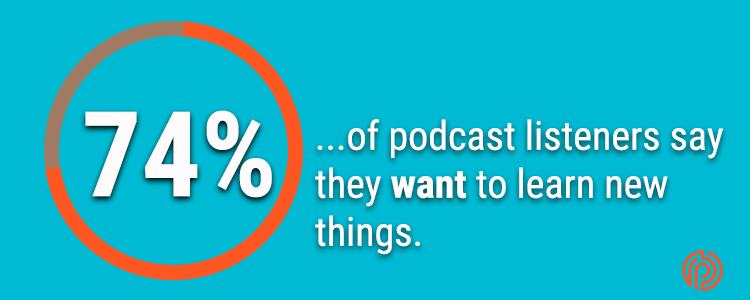Written By:
Will Purcell
When starting a new podcast, it’s important to build a campaign that promotes consistent growth and success. However, when it comes to actually structuring a podcast: What details should be included in your plan? And better yet, what does a proper podcast structure look like? In this article, we will teach you how to:
- Select a format that aligns with your ambitions and goals, but is also feasible.
- Understand your audience, know who you’re speaking to, and establish your podcast as a resource.
- Develop familiarity with a consistent outline for each show.
Regardless of your industry or organization all new business ventures require proper planning. The same can be said for podcasting, building a structured plan is arguably the most important step in creating a new show.
Chances are you have an idea or a topic for a new podcast, but in order to justify the time and commitment required for success, you’ll need a game plan to maximize your efforts.
Need help starting your own podcast? Download our workbook!

The following guide will take you through 5 easy-to-follow steps to efficiently and effectively structure your podcast for audience growth and success.
1. Choose a Show Format
Before your show develops into a well-ranking podcast, it’s important to first understand which format aligns best with your audience and goals. There are several formats to choose from, however, when it comes to selecting the best option it’s important that your format is:
- Realistic
- Repeatable
- Sustainable
- Feasible
For instance, if your business goals are to connect better with your current or potential customers, you might want to incorporate an interview style podcast. In this format, you could speak to past customers to answer common worries during the buying process.
Questions might include: Do you have enough customers to interview? Will they be willing to offer their input? And furthermore, do you have the right equipment to conduct an interview remotely or in person?
These are all necessary questions to ask before launching a podcast with an interview format. Similar questions should be asked for other podcast formats as well. And, just like any other business planning, your podcast formatting goals should be ambitious, but also reasonable.
Most Common Podcast Formats
Interview
Regardless of the theme or topic, interviews can bring a number of benefits to a podcast. Most notably, your audience can enjoy a new perspective from a subject expert, or gain insight into a new topic.
Granted, planning an interview is entirely contingent on your guest’s schedule.With today’s advancements in technology and communication, most interviews can be done from virtually anywhere. That’s why nearly every podcaster utilizes an interview in some capacity.
Need help establishing your podcast interviews? Then check out these 5 tips to get started.
Solo-Cast
Featuring a single host with a lone microphone or front facing camera, solo-cast shows often highlight a specific or specialized topic. Themes can include book/movie reviews, travel tips, or medical insights (just to name a few).
The benefit of a solo-cast format is the timing and logistics of recording sessions are entirely dependent on the host. This allows more flexibility than other show formats, however, it also stresses the importance for the host to conduct adequate research before each session.
Research is not the only requirement in this format, as most solo-cast hosts need to completely understand their podcast equipment, including the troubleshooting guidelines if/when equipment needs to be updated or fixed.
It’s best to choose a solid, but relatively easy setup that delivers results. For an example of what that setup might look like, check out our guide.
Podcast Examples:

Two-Person
The majority of podcast listeners—and consumers in general—are familiar with two-person or 1:1 style shows, as radio and television programs regularly utilize this format for their programs.
Two-person shows are successful because they feature a back-and-forth conversational style approach to each recording. For equipment, two microphones and headsets are usually required for the most professional results, although some table mics are capable of carrying two hosts on one microphone.
Three-Person/Four-Person
These formats require a great deal of commitment from each host to schedule time for recording sessions. However, when done properly, they offer a number of benefits. Most notably, by adding another person(s) to the conversation, the audience can enjoy a different perspective from multiple hosts.
The main challenge includes budgeting for equipment, as more microphones will be needed to accommodate every host. Finding multiple personalities that understand a topic well enough to keep a podcast discussion entertaining and informative can also be difficult.
That’s why for business-focused podcasts looking to grow leads, these formats may work best. For instance, three or four executives from different departments could collaborate and discuss the current issues surrounding their industry and how it relates to consumers.
2. Define Your Audience
Picking a format for your podcast is only half the equation, you need to understand who your audience is and better yet, understand their challenges, interests, goals, and ultimately their reason for consuming your content.
Let’s use the business plan example again: If you’re a business owner looking to grow your reach, you need to know your customers. From there, you can evaluate their common challenges and pain points, which helps to identify topics you can incorporate into podcast episodes to better inform your customers.
In this example, a business would need to understand their ideal customer or “buyer persona”. The same can be said for business’ who are using podcasting to grow leads. The only difference, is the ideal listener must be identified to better understand the needs of your audience.
Creating a Listener Persona
Listener personas are similar to buyer personas in that they are a semi-fictional representation of your ideal listener based on market research and data from your existing audience.
PRO TIP: The best way to get a detailed persona is by talking to real customers on the phone or face-to-face. If that isn’t an option, deep-dive research is your best bet.

Still not sure where to start? Simply ask the right questions to the right people! Online tools, such as surveys, interviews, and website data can help gather the right questions. For an example, check out our guide to student persona interviews to gain an understanding of what questions are relevant in the persona creation process.
Knowing your audience is imperative for podcast growth and success. And remember, persona research is constant. You should continuously gain feedback and information from current listeners to understand the current issues and challenges they’re facing.
3. Answer the Question: Why Should Your Audience Care?
Once you’ve determined your ideal listener and audience, it’s time to align your podcast structure to the simple question: Why should they care?
In other words: Why should someone choose to listen to your podcast? And, once they do listen: Why should they come back and listen to future episodes? These are some of the most difficult questions to answer in podcasting because there’s simply no universal answer. Some podcasts, like book or movie reviews are meaningful because the audience values the opinions of the hosts. Others, like industry themed podcasts, are meaningful because listeners can gain new information that helps in their daily operations.

Ultimately, the question of whether a listener should care about your podcast is something that should be continuously evaluated. Again, think about the basic principles of business—if you become stagnant, it’s likely you’ll become irrelevant.
Research your audience, ask questions on a continuous basis, and find ways to provide solutions to their problems. By doing this, you’ll establish your podcast as a valuable resource, which directly fuels growth.
4. Pick your Host or Hosts
As previously mentioned, your format will have a key influence on the number of hosts that will guide and direct your podcast. Regardless of the number of hosts your podcast uses, it’s important they are:
- Reliable
- Committed
- Knowledgeable
Podcasting requires a great deal of work and effort, so your host should understand the importance of proper research and preparation for each episode.
Your host should also be comfortable talking to people in front of a camera or microphone. Especially for interview-themed podcasts, the host must think quickly to keep the conversation flowing and interesting.
Simply put, a host should be the expert in the audience’s pain points and guide virtually every aspect of the recording to provide solutions to those pain points. Your hosts might be salespeople who are speaking directly to customers, they might be researchers who dive into the demographics of consumers. Having a good mix of people who understand different elements of the business can be key.
5. Create a Show Outline
To recap, at this point you should know your podcast’s format, have an understanding of your ideal audience and why they should consume your content, and choose a committed host. Now it’s time to create a show outline that brings everyone together on the same page. 
The important factor to remember in an outline is consistency.
Think about your favorite content right now—chances are they have a consistent intro, outro, and theme for each episode. Consistency is key because it makes your podcast identifiable and recognizable.
When outlining your show, consider these factors:
- Music: Find the right music that matches the tone of your podcast, then determine when and where you’ll place it (intro, outro, etc.).
- Script: Write a script that maintains consistency, especially at the beginning and end of each show. For example: Do you have sponsor reads? Write these reads into each script at the same time to keep things structured and moving.
- Identify Segments: Basic elements of your show such as the intro, interview, outro should be identified in an outline. This serves to break up ideas and conversations throughout the podcast in a way that’s both understandable and easy to follow.
Additionally, it’s important to provide a detailed list of your podcast equipment and more importantly, how to troubleshoot when things go awry.
Structure your Podcast for Success
When it comes to structuring a podcast, the more prepared you are, the better. The same can be said for a business plan, which for podcast campaigns is essentially the same thing.
Given the amount of research required for each element of a podcast campaign, it’s no surprise that some podcasters can become overwhelmed. Fortunately, there is help available for your podcast.
By seeking the help of a podcasting service, your podcast will have a dedicated partner to guide through each step of your campaign. Whether it’s market research, choosing the right equipment, or technical assistance, podcasting services can help achieve your goals and ultimately grow your reach.







